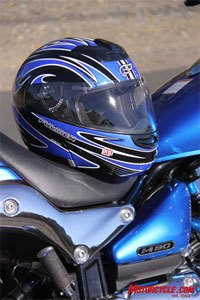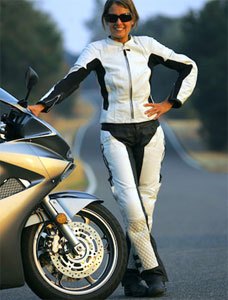MSF Director of Training Systems Dr. Ray Ochs Receives SMSA
Chairperson's Award for Outstanding Contributions to Motorcycle Safety
IRVINE, Calif., August 26, 2010 - Dr. Ray Ochs, director of training systems for the Motorcycle Safety Foundation (MSF), was honored at the annual conference for the National Association of State Motorcycle Safety Administrators (SMSA), held in Columbus, Ohio on August 20-22, 2010.
 Dr. Ochs received the SMSA Annual Chairperson's Award for his "Outstanding Contributions to Motorcycle Safety" in national rider education and training. It was presented by SMSA Executive Committee member Ken Kiphart from the Nevada Department of Public Safety pictured (left) and Dr. Ray Ochs. Photo courtesy of Miriam Romais.
Dr. Ochs received the SMSA Annual Chairperson's Award for his "Outstanding Contributions to Motorcycle Safety" in national rider education and training. It was presented by SMSA Executive Committee member Ken Kiphart from the Nevada Department of Public Safety pictured (left) and Dr. Ray Ochs. Photo courtesy of Miriam Romais.
Each year the SMSA recognizes an individual whose contributions to motorcyclist safety has moved motorcycle rider education and training forward by consistently providing outstanding work and support. The award is intended to recognize the individual's commitment and contributions to motorcycle safety at local, state, and national levels. Nominations are voted upon by a committee composed of the current and former Chairpersons of the SMSA.
"Without fail Ray Ochs has served the needs of current and prospective motorcyclists across the country with great passion and expertise," said MSF President Tim Buche. "His leadership and vision have been instrumental in bringing the MSF's Rider Education and Training System to fruition, offering training and safety renewal opportunities for riders at all skill levels. Among his achievements, he has also been responsible for 'training the trainers' and has logged hundreds of hours leading professional development workshops for MSF RiderCoaches and RiderCoach Trainers. Currently Ochs is working with over fifty subject matter experts through the RETSDOT to sharpen the focus of MSF's RETS and redefine MSF's basic RiderCourse. His many contributions will benefit generations of riders to come, and we're pleased that his achievements have been acknowledged by the SMSA Executive Committee with this prestigious award."
Dr. Ochs has more than 40 years of experience in education, training and leadership functions and has been associated with MSF development programs since its inception in 1973. Ochs's association with the MSF and the RETSDOT program continued in 1997 through a contract with the Traffic Safety Institute at Eastern Kentucky University. Ochs joined the MSF in a leadership position in 2002 where he develops and maintains national curriculum and training functions related to the MSF Rider Education and Training System. Ochs has owned multiple motorcycles in his 44-plus years on the road and currently rides a touring bike. He became an MSF-certified instructor in 1973 and a chief instructor in 1980, and has conducted motorcycle safety training programs and presented papers and presentations in 48 states and throughout the world supporting DOD safety programs and various International Safety Conferences.
Ochs began his career in 1970 as a high school teacher and baseball coach at LeBlond High School in St. Joseph, Mo. He entered academia as a graduate assistant at the Driver Education Instructional Demonstration Center at Indiana State University.
Upon graduating, he was appointed lecturer at Appalachian State University in North Carolina, where he taught undergraduate safety courses, managed laboratory functions for the traffic safety teacher preparation program, implemented a motorcycle safety workshop for driver education teachers and served as a consultant for the North Carolina Department of Education. In 1974, he became an instructor for the Driver Education Center at East Carolina University, where he taught undergraduate and graduate programs in driver and traffic safety education, expanded the university's rider education curriculum and collaborated in the development of the state motorcycle safety program.
Ochs then joined the faculty of Eastern Kentucky University in 1976 as assistant professor at the Traffic Safety Institute, later to earn full professor rank and become the institute's coordinator. Serving EKU for 27 years, he was responsible for expanding the undergraduate curriculum in driver and traffic safety education, implementing several new courses including a for-credit university course in motorcycle safety education, collaborating in the development of legislation for the state motorcycle safety program and serving as project director for several grant-funded state projects including the motorcycle rider education program and other traffic safety projects.
The Motorcycle Safety Foundation promotes rider safety through rider training systems, operator licensing tests and public information programs. The MSF works with the federal government, state agencies, the military, and others to offer training for all skill levels so riders can enjoy a lifetime of safe, responsible motorcycling. Standards established by the MSF have been internationally recognized since 1973.
The MSF is a not-for-profit organization sponsored by BMW, BRP, Ducati, Harley-Davidson, Honda, Kawasaki, KTM, Piaggio, Suzuki, Triumph, Victory and Yamaha. For RiderCourseSM locations, call (800) 446-9227 or visit www.msf-usa.org. RiderCourse Center





